TWO-STAGE ROAD DIET
| Objective | Features | Results |
|---|---|---|
|
|
|
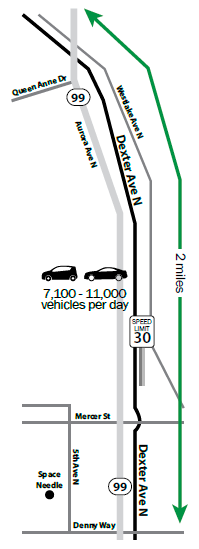
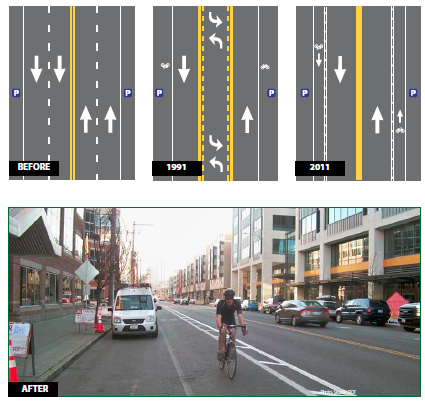
BACKGROUND
More than 20 years ago, Seattle Department of Transportation (SDOT) completed a Road Diet on Dexter Avenue, converting it from a 4-lane roadway to a 3-lane roadway with a bicycle lane in each direction. In 2011, SDOT revisited the design during a planned repaving project. With traffic volumes ranging from 7,100 to 11,000 vehicles per day and a low volume of left-turning vehicles, the SDOT determined a center left-turn lane was unnecessary. Therefore, SDOT went one step further on its original Dexter Avenue Road Diet and converted the 3-lane roadway to a 2-lane roadway with buffered bicycle lanes and bus bulbs.
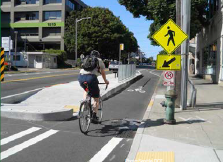 Bicycle lane and floating bus stop |
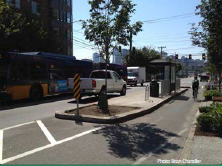 Transit and non-motorized users are prioritized on Dexter |
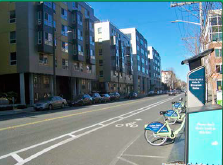 Bicycle rental station utilizes "extra space" |
Dexter Avenue runs north from Seattle's Belltown neighborhood, west of Lake Union. The street is located in a mixed-use area zoned for multi-family housing; the north end of the corridor contains primarily single-family homes.
THE DESIGN
Dexter Avenue is the primary bicycle corridor to downtown, with 300 southbound cyclists in the am peak hour.
Bicycle Lanes. Initially, SDOT considered parking-separated bicycle lanes on Dexter Avenue, but with a high driveway density and relatively steep grade of the roadway, there was a concern that sight distance and visibility could be a safety issue. As an alternative, SDOT placed the bicycle lanes adjacent to the travel lane separated by a 2-ft buffered area.
Transit. SDOT prioritized buses over general purpose traffic by moving several bus stops to in-lane, creating bus bulbs. The bicycle lanes were routed behind the bus stop pads towards the curb, creating "floating" bus stops.
Two-Way Left-turn Lane (TWLTL) Removal. With Aurora Avenue (Washington State Route 99) running parallel near Dexter Avenue on one side and a bluff on the other, there are very few left-turns onto side streets. This allowed SDOT to feel comfortable removing the TWLTL in the corridor. At the few places with significant left-turns, SDOT added left-turn pockets when the two-way left-turn lane (TWLTL) was removed.
Delivery Trucks. The TWLTL had been used by delivery trucks when loading and unloading, so there was concern about losing this space. SDOT added "Load Zones" on the route to address this need.
RESULTS
Public opinion on the Road Diet has been favorable, especially among bicyclists. Dexter Avenue is the primary bicycle corridor to reach downtown, with 300 southbound bicyclists per hour during the AM peak. During the same time, there are approximately 850 motorists per hour heading south. Transit travel times have remained consistent and bus ridership has increased by 30 percent between 2010 and 2013.
Source: National Association of City Transportation Offices (NACTO), "Seattle's Dexter Avenue Bus Bulb," NACTO Urban Street Design Guide. Accessed March 23, 2015. Available at: http://nacto.org/usdg/street-design-elements/curb-extensions/bus-bulbs/
